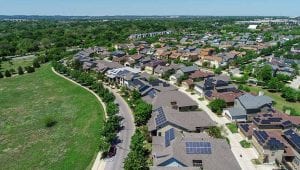General Electric has bowed out of the solar panel-making business, selling its thin-film technology to former market giant, First Solar. Under the deal, GE will hand the cadmium telluride technology it has built up over the last half decade to First Solar in exchange for 1.75 million shares of the struggling US company’s stock. The Wall Street Journal reports that the shares, which would give GE a total 2 per cent stake in the Arizona-based First Solar, were valued at $US81.8 million at Tuesday’s close, but promptly shed 9 per cent of their value in after-hours trading.
First Solar – whose shares took a dive on Tuesday after it reported a 70 per cent drop in profit and cut its forecast for the year after two large sales were delayed – plans to incorporate GE’s thin-film technology into its own manufacturing process, while GE will, in turn, buy First Solar panels for its own installations. It’s a deal, says Bloomberg, which “brings a stakeholder with connections in the utility industry that may help the renewable-energy manufacturer sell large-scale power plants.”
The deal will also allow First Solar to use its manufacturing scale to begin producing GE’s new technology, an outcome which First Solar expects could happen sometime next year. “We will see near-term benefit from access to the GE sales force, particularly on hybrid installations,” First Solar CEO Jim Hughes said yesterday on an earnings call with analysts.
Interestingly, the two companies co-operated on the construction of Australia’s first large scale solar PV farm – the 10MW Greenough River solar plant in Western Australia. First Solar provided the technology, while GE provided some of the funds. The collaboration may well have led to this deal.
As Bloomberg reports, GE – America’s top wind turbine maker – has promoted the concept of hybrid power projects, combining wind and solar energy. It plans to market First Solar panels under its own name, and will now be able to offer both generating technologies to customers, said Anne McEntee, GE’s head of renewable energy. “We’re shifting to what we’re good at, and that’s utility-scale power systems,” McEntee said in an interview yesterday.
In other news…
The US installed more than 1.8GW of new solar PV capacity in the first half of 2013, according to research firm Solarbuzz, pushing the country’s total installations through the 10GW barrier – and making it the fourth country to pass the 10GW milestone. Solarbuzz says America’s rapid uptake of solar PV is being driven by the dramatic system price declines, which have fallen from $6/W two years ago to ~$4.25/W for residential installations and $3/W for large utility-scale PV projects today.
Global solar PV demand is set to reach 20GW in the second half of 2013, driving full year 2013 PV demand to a record high of 35.1GW, according to Solarbuzz. Global PV demand during the first half reached 15GW (up 9 per cent, year-on-year), with more than 60 per cent of the demand coming from just four countries: Germany, China, Japan, and the US. Installations were led by large-scale utility and commercial applications, which provided 45 per cent of first-half demand. In the second half of the year, PV deployment from just two countries – China and Japan – is forecast to account for more than 45 per cent of global PV demand, says Solarbuzz.
South Australian Premier Jay Weatherill has declared new wind energy projects as a “sound investment” for taxpayer dollars. With wholesale prices for wind energy tumbling, Weatherill said that – despite current market uncertainty – he was confident it was the best long-term renewable source. The Premier of the state that is the largest producer of wind energy in Australia made a visit to Whyalla on Wednesday, in what has been seen as a significant signal to local industry and workers. The town’s E and A company has been awarded a contract by global wind power giant Siemens to construct 20 of the 90 towrs needed for the SNowtown-2 project – the state’s largest.










